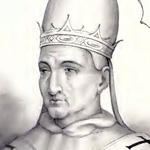
Pope Stephen III was the head of the Catholic Church and prince of the Papal States during the years of August 7, 768 A.D. through his death in early 772 A.D. A Benedictine monk, Stephen served in the pontificate of Pope Zachary within the Lateran Palace.
After the death of Pope Paul I in the brutal papal succession chaos that followed, the Roman church officials elected Stephen as legitimate pontiff. He convened a Lateran Council in 769 A.D. in an effort to restrict the nobles’ influence over the elections of the papacy and to address the practice of iconoclasm.
Brief History and Background on Pope Stephen III
Pope Stephen III Early Years
Stephen was born on the Italian island of Sicily of Greek ancestry to a father named Olivus. He arrived in Rome in the papacy of Pope Gregory III. Stephen joined the Benedictine order as a monk at St. Chrysogonus at this time.
When Pope Zachary was the pontiff, the church ordained Stephen to the priesthood. Pope Zachary took an interest in Stephen and retained him in the Lateran Palace. During the reigns of succeeding pontiffs, Stephen attained high offices to the point that he stood at Pope Paul I‘s bedside as he died in June of 767 A.D.
Pope Stephen III and the Chaotic Papal Succession
Stephen lived through the subsequent chaos of a series of popes and antipopes following the death of Pope Paul I. Unfortunately for the stability of the papacy earthly rulers had taken an interest in obtaining the papal throne and a bitter struggle ensued. The layman Constantine II was maneuvered into the papal throne by his brother Duke Toto of Nepi.
Meanwhile King Desiderius of the Lombards sent an army to Rome to kill Duke Toto and overthrow the antipope Constantine. Having succeeded in his plots, the Lombard king chose his own pope in a monk called Philip. The monk also subsequently fell from the office quickly.
On August 1st of 768 A.D. Stephen’s turn came to be chosen by the church officials as Pope Stephen III. After his August 7th consecration, the new pope sent word to papal protectors and Frankish monarchs Carloman and his brother Charlemagne that he had become the new pontiff.
Pope Stephen III and the Lateran Council
Pope Stephen III called for a Lateran Council in April of 769 A.D. and officially deposed the antipope Constantine as he restricted the nobility’s influence over papal affairs and elections. The church council also formally approved the Eastern Church’s tradition of worshiping icons and increased the cardinal bishops’ rights in the Western Church.
Pope Stephen III Intervenes in Frankish and Lombard Relations
The pope later became embroiled in a scheme to stop a proposed marriage alliance between the Frankish rulers and the family of the Lombard king. When Pope Stephen III finally accepted an alliance in 771 A.D. with the Lombards, it caused a backlash in Rome. The leaders of the pro-Frankish party in the Eternal City were murdered.
In a twist of fate, Frankish King Carloman passed away before he was able to march down and exact vengeance for the injustice. This left his brother Charlemagne as the sole ruler of the Franks and King of the Romans.
Pope Stephen III Quick Facts
- Born – 720 A.D. in Syracuse, Italy
- Birth Name – Stephen
- Died – February 1, 772 A.D. in Rome, Italy
- How he died
In the early part of 772 A.D., the pope became so seriously ill that it became readily apparent he was going to die. Pope Stephen III passed away around February 1, 772 A.D. The church chose Pope Adrian I to succeed him. - Papacy began – August 7, 768 A.D.
- Papacy ended – February 1, 772 A.D.
- Successor – Pope Adrian I
Interesting Facts About Pope Stephen III
- Pope Stephen III mediated between quarrelling Frankish brother Kings Charlemagne and Carloman and then pushed them to lend support to his still-new Papal States through recalling to their minds that Pepin III their father had created the territorial principality in the Donation of Pepin.
- Stephen III begged with the Frankish kings to mediate for him with the Lombards who were pressuring Rome and some territories of the Papal States.
- When Charlemagne proposed a marriage alliance to the Lombard ruler, Pope Stephen III wrote Charlemagne and Carloman protesting the marriage.
- Pope Stephen’s birthplace Sicily long held him to be a saint in the Middle Ages and gave him February 1st as a feast day on their official church calendar.
- Syracuse citizens tried unsuccessfully to persuade the papacy to endorse the sainthood of Pope Stephen III.